
Galicia is an autonomous community of Spain and historic nationality under Spanish law. Located in the northwest Iberian Peninsula, it includes the provinces of A Coruña, Lugo, Ourense, and Pontevedra.

Lugo is a city in northwestern Spain in the autonomous community of Galicia. It is the capital of the province of Lugo. The municipality had a population of 100,060 in 2024, making it the fourth most populous city in Galicia.

Abadín is a municipality in the province of Lugo, Galicia, Spain. It covers 196.1 km2 and has a population of 3,250 for a population density of 16.57/km2. It resides in the region of Terra Cha.
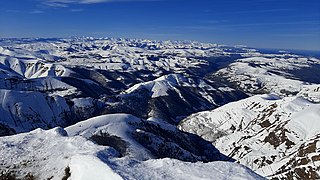
The Cantabrian Mountains or Cantabrian Range are one of the main systems of mountain ranges in Spain. They stretch for over 300 km (180 miles) across northern Spain, from the western limit of the Pyrenees to the Galician Massif in Galicia, along the coast of the Cantabrian Sea. Their easternmost end meets the Sistema Ibérico.
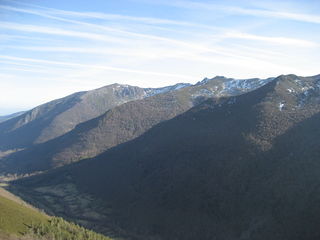
The Serra dos Ancares is a mountain range of the Galician Massif in north-west Spain, extending in a south-westerly direction from the western end of the Cantabrian Mountains in Asturias.

A palloza is a traditional dwelling of the Serra dos Ancares of northwest Spain.
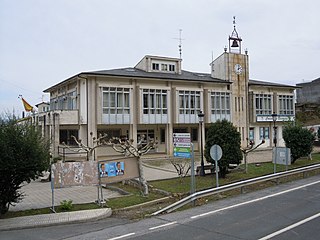
Becerreá is a municipality in the province of Lugo, in the autonomous community of Galicia, Spain. It belongs to the comarca of Os Ancares.

A Fonsagrada is a town and municipality in the province of Lugo in the autonomous community of Galicia in northwest Spain which is 25 miles east-north-east of Lugo by road. Its population in 2004 was 5,007. A Fonsagrada is situated 3,166 feet (965 m) above sea-level on the watershed between the rivers Rodil and Suarna. Historically it was an important market for a variety of agricultural produce, and it manufactured linen and frieze for local trading.

Navia de Suarna, is a municipality in the province of Lugo, in the autonomous community of Galicia, northwestern Spain. It belongs to the comarca of Os Ancares.

Os Ancares is a comarca in the Galician Province of Lugo. The overall population of this local region is 13,888 (2005). It is formed by the municipality of Candín with two slopes, Sil and Navia, and separated by the Ancares pass.

As Nogais is a municipality in the province of Lugo, in the autonomous community of Galicia, Spain. It belongs to the comarca of Os Ancares. It is 57 kilometers from the city of Lugo. It had a population of 1,381 in 2009 according to the Municipal Register of Inhabitants.

Pedrafita do Cebreiro is a municipality in the province of Lugo in Galicia, Spain. It borders the Lugo municipalities of As Nogais, Cervantes, Folgoso do Courel, Samos and Triacastela. Its eastern boundary borders the province of León. It belongs to the comarca of Os Ancares.
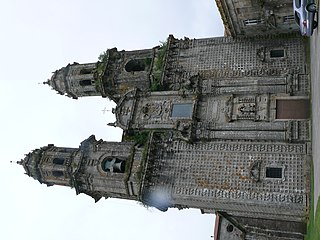
Sobrado is a municipality in the province of A Coruña, in the autonomous community of Galicia, Spain. It has a population of 2,087 and an area of 121 km2. Sobrado is well known because of Sobrado Abbey, a Trappist monastery. The town is known by the name Sobrado dos Monxes in Galician or Sobrado de los Monjes in Spanish but the official name is just Sobrado.

The geography of Galicia (Spain) is characterized by the contrast between the low altitude coastal relief and, further inland, by the higher altitude of the Galician Massif which itself offers contrasts between the morphology of the high northern plains and the southern mountains and valleys.
Galicia is divided into comarcas. In Galician, comarcas are sometimes also called bisbarras. There are 53 comarcas in Galicia.
Saavedra is a Galician surname derived from places named Saavedra in the Ourense and Lugo provinces of Galicia, Spain. Saavedra consists of the Galician words saa, meaning "hall" and vedro, meaning "old". Related surnames include Saabedra, Sabedra, and Savedra. The surname Saa is also common.

The Galician Massif or Galician-Leonese Massif is a system of mountain ranges in the northwestern corner of the Iberian Peninsula. It is located in Galicia with its southeastern end reaching into the provinces of Zamora and León of Castile and León. Its highest point is Pena Trevinca at 2,127 metres (6,978 ft). Another important peak is Cabeza de Manzaneda.

The Galician National-Popular Bloc was a Galician electoral candidacy. It had as the national sovereignty for Galiza as its main objective and as an alternative to autonomism. It was formed by the Galician People's Union (UPG) and Galician National-Popular Assembly (ANPG).
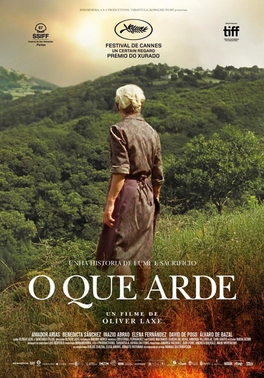
Fire Will Come is a 2019 Galician-language drama film directed by Oliver Laxe. Filmed in the Serra dos Ancares area of Galicia, many of the cast were local people and not professional actors.

Galicia irredenta or Galicia estremeira, also spelled as Galiza irredenta and Galiza estremeira and also known as Faixa Leste or Franxa Leste, is a term used for all Galician-speaking territories located outside of Galicia. These are all located in Spain, in either Asturias or Castile and León. These territories are sometimes divided into three subregions: El Bierzo, Eo-Navia and As Portelas.




















